Roger Donne’s Miscellany |
|
|
About This Site |
Cycling |
Family History |
Contact Me |
Site Map |
Links |
Notes On Landulph Church
This is a transcript of a booklet (published by S.P.C.K., London) written by the Rev. J. H. Adams, who was Rector of Landulph from the 1930s to the 1950s. His comments on the condition of the church apply to the time of writing, believed to be the mid 1930s, and may no longer be current. However, the historical content and the names quoted will still be of interest generally or to family historians.
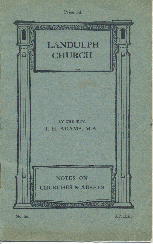 Dedication
Dedication
Architecture
Furnishings
The Monuments
The Bells
The Old Glass
The Church Plate
The Parish Registers
The Palaeologus Family
The Lower Family
DEDICATION
The prefix "Lan" in a name denotes generally that it was the monastic settlement of a Celtic saint. These Celtic saints usually travelled by water, and hence we constantly find their settlements, represented by churches, close by the river estuaries where they landed. Landulph is one of many Cornish churches so situated. From 1286 at last the name was spelt Landylp or Landilpe, etc., and it has therefore been generally assumed that it is the "lan" or settlement of saint named Dilpe. In 1559 a wall painting of Dylytt was destroyed by order of the Royal Commissioners. Mr. C. Henderson discovered in the Public Record Office a Chancery suit of 1515-16 concerning Michael Vawgh, parson of St.Dilecta, of Landulph. Mr. Henderson says that "Dilecta supposes a Celtic original Delec or Delech," and argues that Landulph is a corruption of Landelech, a name which occurs in Domesday and has never been satisfactorily identified. He therefore maintains that the true patron of the church is St. Delech or Dilecta. The Victoria County History edition of Domesday survey of Cornwall identifies Landelech with Landlake in South Petherwin, but a deed of temp. Edward IV, or Richard III, speaks of Landhilp, alias Landylike, which seems clearly a variant of Landelec.
In the 15th century, the church was rededicated to St. Leonard. Both saints were represented in wall paintings which were destroyed in 1559. The remains of the feet of one of them were discovered at the east end during the restoration of 1900, but there was not enough to preserve.
ARCHITECTURE
12th Century - Of the Norman church nothing remains but the two base stones of the west doorway (exterior), the base of the font, which has been reworked in later times according to E. H. Sedding, and the two carved stone heads now supporting roof brackets on either side of the entrance to the chancel. The one on the north side is a corbel, while Mr. R. F. Wheatly suggests that the other is almost certainly from a corner of a font bowl of the Bodmin type, about 1190 in date.
14th Century - The Norman church seems to have been pulled down and rebuilt early in this century, but nothing remains of the new work except the outer porch doorway, the base to the north-west pier in the nave, and a few loose stones of the same type among those in the north-east corner of the church. The two lower stages of the tower may belong to this building too.
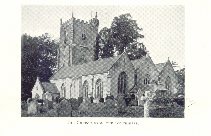 15th Century - About 1420 the church was again largely rebuilt, but still in the "Decorated" style usually termed "14th
Century." Architecture (like all else) was fifty years or so behind the times Cornwall. The nave arcade, the windows, the inner porch doorway, and the piscina (now in two
separated portions) all belong to this period. The north aisle is slightly earlier than the south. The roof, though restored, contains much of the old timber, and the bosses are
of a different type to those in the south aisle. The piers and capitals are slightly different, too, in their proportions, though of the same design. It was during this century
probably that the upper stage, with its angle buttresses, was added to the tower. This was a time of great delight in wood carving, and towards the end of the century the screen was
erected (of which only the bases of the central and southern portions are original) and the rood-loft stairs were built out from the south wall. The bench ends and probably the old
almsbox also belong to this period. It may have been at this time, too, that the nave roof was raised and a clerestory was added.
15th Century - About 1420 the church was again largely rebuilt, but still in the "Decorated" style usually termed "14th
Century." Architecture (like all else) was fifty years or so behind the times Cornwall. The nave arcade, the windows, the inner porch doorway, and the piscina (now in two
separated portions) all belong to this period. The north aisle is slightly earlier than the south. The roof, though restored, contains much of the old timber, and the bosses are
of a different type to those in the south aisle. The piers and capitals are slightly different, too, in their proportions, though of the same design. It was during this century
probably that the upper stage, with its angle buttresses, was added to the tower. This was a time of great delight in wood carving, and towards the end of the century the screen was
erected (of which only the bases of the central and southern portions are original) and the rood-loft stairs were built out from the south wall. The bench ends and probably the old
almsbox also belong to this period. It may have been at this time, too, that the nave roof was raised and a clerestory was added.
At some subsequent date unknown it was found that the clerestory was too heavy for the earlier piers, which were never intended to carry such weight. It was therefore taken down and the roof considerably lowered. The heavy window heads now lying at the east end of the south aisle are probably parts of this clerestory. They were taken during the restoration of 1900 from a huge buttress which propped up the north wall.
17th Century - The sundial base in the churchyard opposite the porch is dated 1690.
18th Century - Near the window heads referred to above is a stone inscribed "J. H. 1723." This came from the chancel gable, and shows that a very inferior east window (since replaced by the present one) was inserted in the time of John Harris (Rector 1720-1735). Perhaps the whole chancel was restored at this time.
20th Century - No further important work appears to have been done till the 20th century. By this time the church was in a deplorable condition, with the north aisle in imminent peril of collapsing, the nave arches leaning heavily, and rain streaming through the roof in wet weather. Owing to the exertions of the Rev. S. Gregory (Curate 1896-1900 and Rector 1900-1922), funds were raised, and the whole church, with the exception of the tower, was thoroughly restored under the direction of Mr. Fellowes Prynne. Money is now needed to complete the work by refacing the tower (transcript note - this applies to the time of writing, circa 1935; more recently, further work was required on the church roof and a substantial re-roofing project was completed in 2005).
FURNISHINGS
The Font. - The base is probably Norman. The plain octagonal bowl of Roborough stone has the following inscription very crudely cut round three of the sides: "Suffer the little children to come unto me and forbid them not. S. Y. 1660." S. Y. may represent the initials of the donor.
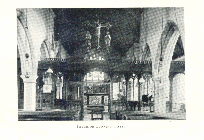 The Screen - The lower central and south aisle portions are original 15th-century work. They were repaired during
the war (transcript note: Rev. Adams is referring to the First World War 1914-18) with money left by an old housekeeper of the then Rector and the work was done by a Belgian refugee.
The Rev. I. S. Jenkins (Rector 1924-1929) raised funds for the erection of the upper central portion and the rood figures, while the two aisle sections were given by a most generous donor who
wishes to remain anonymous, 1931-1932.
The Screen - The lower central and south aisle portions are original 15th-century work. They were repaired during
the war (transcript note: Rev. Adams is referring to the First World War 1914-18) with money left by an old housekeeper of the then Rector and the work was done by a Belgian refugee.
The Rev. I. S. Jenkins (Rector 1924-1929) raised funds for the erection of the upper central portion and the rood figures, while the two aisle sections were given by a most generous donor who
wishes to remain anonymous, 1931-1932.
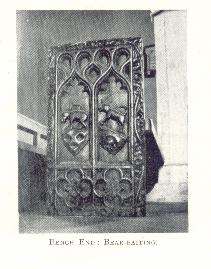 The bench-ends can be dated within a few years. The third from the east on the south side of the north aisle bears the
arms of Courtenay surmounted by a Bishop's mitre and the arms of the See of Exeter. Peter Courtenay was consecrated Bishop of Exeter in 1477 and translated to Winchester in 1486, so
evidently the Landulph bench-ends were erected between those two dates. They all appear to be of the same style and date except one - the westernmost on the north side of the north
aisle. This is quite different in style and was found at the restoration under the floor. Others of interest are the arms (three bells) of the Priory of St. Germans, which owned
the manor of Tinnel in this parish, three rudders (badge of Willoughby de Broke), eagle and bundle of sticks (badge of Courtenay), three feathers (ditto), and several amusing secular subjects
(fox and goose, bear-baiting, a bat, boar's head, and possibly a goose preaching from a pulpit, though this is more probably s serpent or dragon issuing from a chalice, the emblem of St. John
the Evangelist). It will be noticed that most of the bench-ends have modern borders. In the 18th century, hideous deal "horse-box" pews were erected over the old bench-ends and
the borders were ruthlessly cut away to make a flat surface for the joints. The "horse-box" casings have been made into panelling which lines the interior of the belfry. The
panelling along the west wall consists of the ends and doors of the family pews of Sir Nicholas Lower of Clifton in this parish. They are fine specimens of Jacobean carving, dated 1631.
The bench-ends can be dated within a few years. The third from the east on the south side of the north aisle bears the
arms of Courtenay surmounted by a Bishop's mitre and the arms of the See of Exeter. Peter Courtenay was consecrated Bishop of Exeter in 1477 and translated to Winchester in 1486, so
evidently the Landulph bench-ends were erected between those two dates. They all appear to be of the same style and date except one - the westernmost on the north side of the north
aisle. This is quite different in style and was found at the restoration under the floor. Others of interest are the arms (three bells) of the Priory of St. Germans, which owned
the manor of Tinnel in this parish, three rudders (badge of Willoughby de Broke), eagle and bundle of sticks (badge of Courtenay), three feathers (ditto), and several amusing secular subjects
(fox and goose, bear-baiting, a bat, boar's head, and possibly a goose preaching from a pulpit, though this is more probably s serpent or dragon issuing from a chalice, the emblem of St. John
the Evangelist). It will be noticed that most of the bench-ends have modern borders. In the 18th century, hideous deal "horse-box" pews were erected over the old bench-ends and
the borders were ruthlessly cut away to make a flat surface for the joints. The "horse-box" casings have been made into panelling which lines the interior of the belfry. The
panelling along the west wall consists of the ends and doors of the family pews of Sir Nicholas Lower of Clifton in this parish. They are fine specimens of Jacobean carving, dated 1631.
The plain oak panelling along the north wall is part of a faculty pew which stood in front of the pulpit and sadly marred the appearance of the church. The present owner (transcript note: a descendant of Benjamin Snell, who occupied the property circa 1809), on inheriting the Wayton property in 1932, kindly sanctioned its removal. The canopies above the belfry screen are the separated halves of the sounding board of the 18th-century "three-decker" pulpit.
In the belfry are some quaint 18th-century Ringer's Rhymes.
The hatchment over the vestry door is that of the Rev. John Wood, who married Thomasine, daughter of the Rev. Job Brookes (Rector 1683-1720). Its date is 1736. It is in bad condition, but represents Azure, three garbs (or sheaves) or, impaling or, a cross engrailed gules and sable.
The brass urn standing on the sill of the south-east window originally surmounted the 18th-century wooden panelling above the altar.
THE OLD GLASS
The 17th-century Lower arms in the south aisle was, some years ago, in the east window of the aisle, but was removed when the present window was inserted. It was taken away by a firm of glass-makers and appears to have been entirely forgotten till a chance remark of the present incumbent about the unfortunate loss of the old glass recalled it to memory, and it was recovered by a retired incumbent. Old histories refer to the arms of Lower, Courtenay and Reskymer as remaining in the windows. Fragments of the Courtenay arms were made up by the Rev. F. V. J. Arundell, but instead of being returned to the church were inserted in the Rectory, where they still remain.
THE BELLS
There are six bells, all cast originally by FitzAnthony Pennington
of Lezant, in 1786. Two, however, have been recast since.
THE MONUMENTS
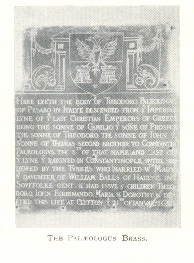 The monument which makes Landulph famous is the brass near the vestry door commemorating
Theodore Palaeologus, a direct descendant of the Byzantine Emperors. The date of his birth appears to be unknown, but on July 6, 1593, he married, in the island of Chios,
Eudoxia Commena, who died in 1596, leaving a daughter, Theodora, who (October 10, 1614) married Prince Demetrius Rhodocanakis at Naples. She had several children, one of whom, Dr.
Constantine Rhodocanakis (born December 5, 1635 at Rhodocanakis Castle, Isle of Chios), was a well known physician and scholar and friend of King Charles II., whom he met during his
exile. Theodore Palaeologus not long after his first wife's death came to England, and in 1600 was "Rider to Henry Earl of Lincolne" at Tattershall Castle. There he met the
celebrated Captain John Smith, who had recently returned from service on the Continent, and at the age of only 21, "being glutted with too much company wherein he took small delight,"
had retired into the woods about Tattershall, where he led a solitary hermit-like existence. His friends "perswaded one Seignor Theadora Polalga......a noble Italian Gentleman, to
insinuate into his woodish acquaintances" and gradually drew him back into normal society. In the same year, May 1, 1600, Palaeologus married at Cottingham, Yorkshire, his second wife -
Mary Balls. For the next twenty-five years nothing more is known of him, but he was probably fighting as a soldier of fortune on the Continent most of the time. On March 19,
1627-28, he was in Plymouth, and wrote from there a letter to the Duke of Buckingham, begging to be taken into the King's service. The Duke's reply is unknown, but even if favourable it
came to nothing. Palaeologus appears to have owned a small property in Plymouth, for his name appears among the monthly assessments for the relief of the poor in Old Town Ward for the
year 1628, being rated at one halfpenny per week. At some time, presumably after this date, Palaeologus and his daughters (the sons were probably grown up and seeking their fortune
elsewhere) came to Landulph, and apparently lived with Sir Nicholas and Lady Lower at Clifton. Lady Lower was the daughter of Sir Henry Killigrew, who married one of the daughters of
Sir Anthony Coke, who were so celebrated for their learning. It has been suggested that she inherited some of her mother's love of the classics, and that she and her husband, old and
childless, may have enjoyed the company of the Greek Palaeologus and studied classics with him. On December 23, 1656, Dorothy Palaeologus was married here (or possibly at St.
Mellion - the marriage is recorded in both registers) to William Arundell, and both daughters were buried here (Mary on May 15, 1674, and Mrs. Arundell July 12, 1683). Theodore himself
died, according to the brass, on January 21, 1636. Unfortunately the parish register for this period is incomplete, but the Rev. F. V. J. Arundell, after much search among the archives
at Exeter, unearthed the Bishop's transcripts for 1636, containing the entry, "Theodore Palaeologus was buryed the 20th day of October." This is clearly one of the many instances of
inaccuracies on monuments erected some time after the death of the person commemorated. About the year 1795 the vault containing the body of Palaeologus was accidentally broken into,
revealing an oak coffin, which was opened. The body was well preserved, "in stature much above the common height, his countenance oval in form, much lengthened, and marked by an
acquiline nose, and a very white beard, reaching low on the breast."
The monument which makes Landulph famous is the brass near the vestry door commemorating
Theodore Palaeologus, a direct descendant of the Byzantine Emperors. The date of his birth appears to be unknown, but on July 6, 1593, he married, in the island of Chios,
Eudoxia Commena, who died in 1596, leaving a daughter, Theodora, who (October 10, 1614) married Prince Demetrius Rhodocanakis at Naples. She had several children, one of whom, Dr.
Constantine Rhodocanakis (born December 5, 1635 at Rhodocanakis Castle, Isle of Chios), was a well known physician and scholar and friend of King Charles II., whom he met during his
exile. Theodore Palaeologus not long after his first wife's death came to England, and in 1600 was "Rider to Henry Earl of Lincolne" at Tattershall Castle. There he met the
celebrated Captain John Smith, who had recently returned from service on the Continent, and at the age of only 21, "being glutted with too much company wherein he took small delight,"
had retired into the woods about Tattershall, where he led a solitary hermit-like existence. His friends "perswaded one Seignor Theadora Polalga......a noble Italian Gentleman, to
insinuate into his woodish acquaintances" and gradually drew him back into normal society. In the same year, May 1, 1600, Palaeologus married at Cottingham, Yorkshire, his second wife -
Mary Balls. For the next twenty-five years nothing more is known of him, but he was probably fighting as a soldier of fortune on the Continent most of the time. On March 19,
1627-28, he was in Plymouth, and wrote from there a letter to the Duke of Buckingham, begging to be taken into the King's service. The Duke's reply is unknown, but even if favourable it
came to nothing. Palaeologus appears to have owned a small property in Plymouth, for his name appears among the monthly assessments for the relief of the poor in Old Town Ward for the
year 1628, being rated at one halfpenny per week. At some time, presumably after this date, Palaeologus and his daughters (the sons were probably grown up and seeking their fortune
elsewhere) came to Landulph, and apparently lived with Sir Nicholas and Lady Lower at Clifton. Lady Lower was the daughter of Sir Henry Killigrew, who married one of the daughters of
Sir Anthony Coke, who were so celebrated for their learning. It has been suggested that she inherited some of her mother's love of the classics, and that she and her husband, old and
childless, may have enjoyed the company of the Greek Palaeologus and studied classics with him. On December 23, 1656, Dorothy Palaeologus was married here (or possibly at St.
Mellion - the marriage is recorded in both registers) to William Arundell, and both daughters were buried here (Mary on May 15, 1674, and Mrs. Arundell July 12, 1683). Theodore himself
died, according to the brass, on January 21, 1636. Unfortunately the parish register for this period is incomplete, but the Rev. F. V. J. Arundell, after much search among the archives
at Exeter, unearthed the Bishop's transcripts for 1636, containing the entry, "Theodore Palaeologus was buryed the 20th day of October." This is clearly one of the many instances of
inaccuracies on monuments erected some time after the death of the person commemorated. About the year 1795 the vault containing the body of Palaeologus was accidentally broken into,
revealing an oak coffin, which was opened. The body was well preserved, "in stature much above the common height, his countenance oval in form, much lengthened, and marked by an
acquiline nose, and a very white beard, reaching low on the breast."
Of his three sons. John is said to have fought for the King in the Civil War, and was probably killed at Naseby. Theodore's name occurs among the lieutenants in the army sent against the Scots in 1640. When the Civil War broke out, he sided with Parliament, and his name occurs again as a lieutenant in the Earl of Essex's army in 1642. In 1644 he died or was killed, and was buried in Westminster Abbey (May 3) near Lady St. John's tomb in the north transept. He served in Lord St. John's regiment which no doubt accounts for his burial here. A manuscript in the House of Lords contains a draft order dated May 3, 1644, for payment of £50 to Sir Philip Stapledon, being part arrears of pay due to Captain Palaeologus.
Ferdinand, who probably fought with his brother John on the Royalist side, retired to on the victory of the Commonwealth to Barbados in the West Indies, where his mother's family owned property. In 1649, his name occurs as vestryman of the parish of St. John, and thereafter he held a number of parochial offices, including that of churchwarden (1655 and 1657). He died in 1678 and was buried at St. John's on October 3. His will, dated September 26, 1670, is preserved. A hurricane in 1831 destroyed the church of St. John, and his coffin was discovered under the organ loft in the vault of Sir Peter Colleton. Some years later it was opened, and revealed a skeleton of extraordinary size (like his father's embedded in quicklime. The coffin was carefully deposited in another vault, and in 1909 a tablet was erected over it with an inscription partly borrowed from the the Landulph brass. By his will Ferdinand divided his property between his widow Rebecca and his son "Theodorious," the widow to be trustee till he should attain the age of fourteen years. In 1680 Theodorious died and was buried in the cathedral parish of St. Michael. He was the last descendant in the male line of this branch of the Palaeologus family. A sailor signing his will Theodore Paleologey died at sea in 1693, and has been variously described as a son of Ferdinand or of his elder brother Theodore, but he was probably no relation.
Near the Palaeologus brass stands the tomb of Sir Nicholas Lower, who is also commemorated by a brass on the south wall near by, and adjoining it is one which was erected to the memory of his wife.
Although not one of the oldest Cornish families, the Lowers had intermarried latterly with some of the greatest, and (as shown on the pedigree at the west end of the church) Sir Nicholas Lower could claim descent from Edward I., King John (by another descent), Malcom III., King of Scotland, and his wife St. Margaret, Henry I., King of France, and Richard, first Duke of Normandy, besides many of the most powerful families of the Middle Ages. Lady Lower (who had twice been married before) was a cousin of Sir Nicholas, and in fact a niece of his great-grandmother!
Set in the floor on the south side of the Lower tomb is a stone in memory of Edward Amerideth, Rector of Landulph 1643-1661, who was drowned when returning from a visit to his father-in-law at Catchfrench.
On the north wall behind the organ is a quaint monument to the memory of an 18th-century schoolmaster, which is said to have been engraved by himself. It reads as follows:
"A MEMORIALL
Here underneath One buri'd was
Which kept a Schooll at Painter's Cross
Wherein his dayes ∓ Yeares were Spent
Not for much gaine, yet with content
This Parish was hee did live in
His Place therein was Stockadon
Hee kept his Church ∓ all things neat
And when therein Here was his Seat
GOD send you then Another such
Your Children well his lawes to teach
To him therefore that craves his name
This stone henceforth doth show ye same
Alexander Moone, Objit
Anno Dom'i 1774
Aged Years"
In the belfry is the monument of FitzAnthony Pennington, one of the well-known firm of bellfounders. He re-cast the Landulph bells in 1786, and was drowned when bringing one of them over Antony passage. The receipted account for the re-casting of the bells is still preserved in the parish chest. It was paid to one of his brothers.
THE CHURCH PLATE
The silver chalice and paten in general use are modern, given by the Rev. S. Gregory, but there are two magnificent Charles I chalices with cover patens.
There are also three very large and heavy pewter flagons of unknown date, one of which has lost its lid.
THE PARISH REGISTERS
The parish registers date from 1540, though there are unfortunately several gaps.
Overseers' accounts date from 1721 and churchwardens' from 1760, though there are two half-sheets of rough notes, 1578-1581 and 1590-1593.
There are also 15th-century deeds and leases.